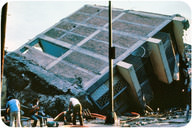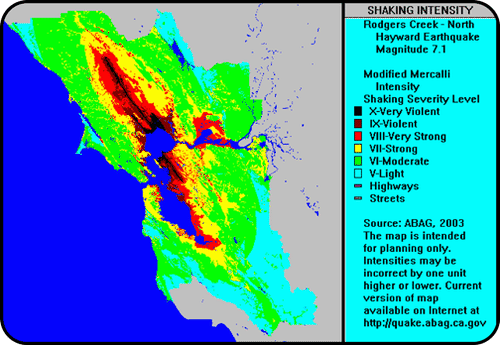6.18地震灾害
章节大纲
-
Is earthquake magnitude the most important factor in determining damage?
::地震规模是否是确定损害的最重要因素?The type of construction has a tremendous effect on what happens during an . Damage and deaths are directly affected by the construction in an earthquake. For example, enormous damage was done in the 2011 Christchurch, New Zealand earthquake. However, far less was damaged in an earthquake of the same magnitude near the area in Iceland seen above.
::例如,2011年新西兰的克赖斯特彻奇地震就造成了巨大破坏,然而,在靠近上述冰岛地区的同样规模的地震中,破坏的更小。Damage from Earthquakes
::地震造成的破坏We know that earthquakes kill lots of people. However, the ground shaking almost never kills people. Unlike in cartoons, the ground does not swallow someone up! Deaths depend somewhat on an earthquake's size and the type of ground people inhabit. But a very important factor is the quality of the structures. People are killed when structures fall on them. More damage is done and more people are killed by the fires that follow an earthquake. Of course, the number of deaths is different from the property damage that a quake does.
::我们知道地震会杀死很多人。然而,地面震动几乎永远不会杀死人。与漫画不同,地面不会吞噬人!死亡在某种程度上取决于地震的规模和地面居民的类型。但一个非常重要的因素是结构的质量。当建筑物倒塌时,人们就会死亡。地震后的火灾造成更多的破坏,更多的人死亡。当然,死亡人数与地震造成的财产损失不同。What Makes Earthquakes Deadly?
::地震是什么致命的?What makes an earthquake deadly?
::地震何以致命?- Population density. The magnitude 9.2 Great Alaska Earthquake, near Anchorage, of 1964 resulted in only 131 deaths. At the time few people lived in the area ( Figure ).
::人口密度:1964年在安克雷奇附近发生的9.2大阿拉斯加地震仅造成131人死亡,当时在该地区生活的人很少(图......)。
A landslide in a neighborhood in Anchorage, Alaska, after the 1964 Great Alaska earthquake. - Size, but not size. No one dies in a magnitude 1.0 earthquake. But large quakes do not always kill a lot of people. Only about 2,000 people died in the 1960 Great Chilean earthquake. This was the largest earthquake ever recorded. The Indian Ocean earthquake of 2004 was one of the largest ever. Still, most of the 230,000 fatalities were caused by the , not the earthquake.
::大小, 但不是大小。 没有人会在1.0级地震中死亡。 但是大地震并不总是杀死很多人。 在1960年智利大地震中,只有大约2,000人丧生。 这是有史以来史上最大的地震。 2004年印度洋地震是有史以来最大的地震之一。 然而, 230,000人死亡者大多是地震造成的,而不是地震造成的。
- Ground type. Solid bedrock vibrates less than soft sediments , so there is less damage on bedrock. Sometimes sediments become saturated with water . They then undergo liquefaction and become like quicksand ( Figure ). Soil on a hillside may become a landslide .
::地面类型。 固基基体振动小于软沉积,因此基体的损害较小。 有时沉积物与水饱和,然后进行液化处理,变成像流沙一样(图 ) 。 山坡上的土壤可能变成山崩。
Liquefaction of sediments in Mexico City caused the collapse of many buildings in the 1985 earthquake. City Planning
::城市规划In earthquake-prone areas, city planners try to reduce hazards. They look at both the likelihood of a quake and the damage one would do. For example, in the San Francisco Bay Area, show how much shaking is expected for different ground types ( Figure ). This allows planners to locate new hospitals and schools more safely.
::在地震易发地区,城市规划者试图减少灾害。他们既观察地震的可能性,也观察地震造成的破坏。例如,在旧金山湾地区,显示不同类型地面的摇晃(图 ) 。 这使得规划者能够更安全地找到新的医院和学校。The expected Modified Mercalli intensity scale for an earthquake of magnitude 7.1 on the northern portion of the Hayward Fault. Summary
::摘要- Seismic waves rarely kill anyone. Structures falling on people and fires or tsunamis after the earthquake cause many more fatalities.
::地震波很少杀死任何人。 地震发生后,地震和火灾或海啸造成的结构倒塌造成更多人死亡。
- City planning can lessen the damage done by earthquakes.
::城市规划可以减少地震造成的破坏。
- Population density and ground type affect the number of fatalities.
::人口密度和地面类型影响到死亡人数。
Review
::回顾- What causes liquefaction? Why is it damaging?
::是什么导致液化?为什么它具有破坏性呢?
- A 9.2 earthquake struck near Anchorage, Alaska in 1964, but few people died. If a similar quake struck today, how many fatalities would there be compared with the quake in 1964? Explain your reasoning.
::1964年阿拉斯加Anchorage附近发生9.2次地震,但死亡人数很少。 如果今天发生类似的地震,那么与1964年地震相比,死亡人数会有多少?解释一下你的推理。
- Why do city planners look at Mercali maps rather than predictions of earthquake magnitude?
::为什么城市规划者只看Mercali地图而不是地震规模的预测?
- Population density. The magnitude 9.2 Great Alaska Earthquake, near Anchorage, of 1964 resulted in only 131 deaths. At the time few people lived in the area ( Figure ).



